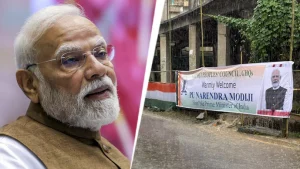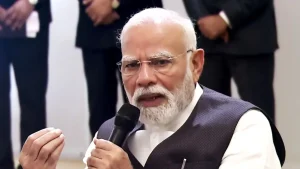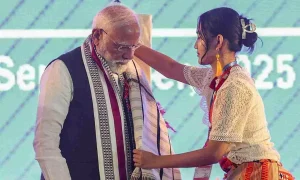Prime Minister Narendra Modi’s recent visit to Manipur marked a pivotal moment in addressing the state’s ongoing ethnic tensions. His Modi Manipur peace message resonated across two locations 60 kilometres apart, delivering a unified call for harmony between conflicting communities while outlining an ambitious development agenda for the troubled northeastern state.
Also Read: Modi Manipur peace message
Other: PM Modi Tour Five States
 The Modi Manipur peace message centred on a compelling narrative that the aspirations of Manipur’s youth should not be “buried under the dark shadow of violence.” Speaking at development project inaugurations in areas dominated by different ethnic communities, the Prime Minister emphasised that the state’s potential remains untapped due to ongoing conflicts between the Meitei and Kuki-Zo communities.
The Modi Manipur peace message centred on a compelling narrative that the aspirations of Manipur’s youth should not be “buried under the dark shadow of violence.” Speaking at development project inaugurations in areas dominated by different ethnic communities, the Prime Minister emphasised that the state’s potential remains untapped due to ongoing conflicts between the Meitei and Kuki-Zo communities.
The violence that began in May 2023 has resulted in 258 deaths and displaced 60,000 people according to government figures, making the Modi Manipur peace message particularly significant for the region’s healing process. The Prime Minister’s strategic choice to deliver speeches in both valley and hill areas demonstrated his commitment to addressing all communities equally.
Modi’s approach intertwined development initiatives with peace-building efforts. Each project announcement served as a building block in his larger Modi Manipur peace message about progress through unity. The Prime Minister specifically highlighted how infrastructure development, educational opportunities, and economic growth could serve as alternatives to conflict.
“Manipur is a land of great possibilities. It is our duty not to keep even one foot wrong on the road to development,” he stated, emphasising that the state possesses abundant capabilities but requires sustained dialogue between communities. This pragmatic approach within his Modi Manipur peace message acknowledged existing tensions while proposing concrete solutions.
A cornerstone of the Modi Manipur peace message focused extensively on the state’s remarkable sporting achievements. Modi strategically leveraged Manipur’s reputation as India’s sporting powerhouse to inspire youth toward constructive paths rather than violence.
“Without Manipur’s players, India’s sports are incomplete. Manipur’s youth fight for the pride of the Tricolour. We cannot let this identity be buried under the dark shadow of violence,” he declared. This sports-centric element of his Modi Manipur peace message resonated strongly, given that Manipur has produced numerous Olympic medalists and international athletes despite ongoing conflicts.
The Prime Minister connected sporting excellence with national pride, suggesting that as India emerges as a global sports powerhouse, Manipuri youth bear greater responsibility to contribute positively rather than engage in destructive activities.
The Modi Manipur peace message placed significant emphasis on shared responsibility between communities and government intervention. Modi acknowledged that while communities must work together, the central government has an active role in facilitating dialogue and restoring normalcy.
“The government is undertaking talks with different groups from both the hills and the valley,” he revealed, indicating ongoing behind-the-scenes diplomatic efforts. This transparency within his Modi Manipur peace message demonstrated the government’s commitment to finding sustainable solutions rather than temporary fixes.


A significant component of the Modi Manipur peace message positioned the Northeast as India’s next economic frontier. Modi argued that while Southern and Western India have previously driven the country’s growth, the time has arrived for the Northeast to capitalise on development opportunities.
“Imphal city is a city of possibilities. I see Imphal as a city that will realise the dreams of the youth and contribute to the country’s growth,” he stated. This economic vision within his Modi Manipur peace message offered tangible incentives for peace, suggesting that continued violence would prevent the region from achieving its economic potential.
The ethnic conflict between the Meitei and Kuki-Zo communities has complex local and national political dimensions, making economic development a crucial tool for conflict resolution.
Throughout his addresses, the Modi Manipur peace message consistently returned to themes of mutual understanding and dialogue. Modi emphasised that harmony between communities represents not just a moral imperative but a practical necessity for achieving development goals.


The geographical strategy behind delivering the Modi Manipur peace message at two locations 60 kilometres apart demonstrated sophisticated political messaging. By addressing both valley-dwelling Meiteis and hill-dwelling Kuki-Zos separately yet consistently, Modi avoided appearing to favour either community while maintaining unified messaging.
This approach within his Modi Manipur peace message acknowledged existing divisions while working to bridge them through shared development aspirations and national identity.
The comprehensive Modi Manipur peace message represents more than political rhetoric; it outlines a transformation pathway from conflict to cooperation. By connecting development projects with peace-building, leveraging sports achievements for inspiration, and positioning the Northeast as an economic opportunity zone, Modi crafted a compelling narrative for change.
The success of this Modi Manipur peace message will ultimately depend on sustained government efforts, community cooperation, and the youth’s willingness to choose development over division. As India continues its growth trajectory, Manipur’s integration into this success story remains both a challenge and an opportunity that could define the region’s future for generations to come.

